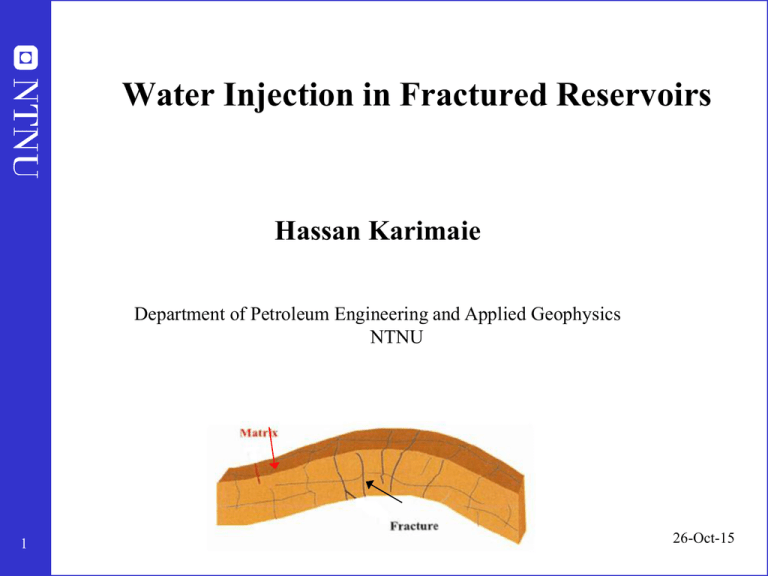Water Injection Lecture by Hassan Karimaie Oct. 16, 2015
advertisement

Water Injection in Fractured Reservoirs Hassan Karimaie Department of Petroleum Engineering and Applied Geophysics NTNU 1 26-Oct-15 Outline: Background Matrix / fracture system in fractured reservoirs Water injection in NFR 2 Normal procedure in industry: Immersion test or Amott test Water rising in the fracture or Immersion? Cocurrent and Counter current imbibition Experiments Results and discussion Conclusion References 26-Oct-15 Background Unique feature of NFR: Early breakthrough of injected fluid More uniform fluid composition Small pressure drop Absence of transition zone Matrix Invaded Zone Water or Gas Oil Fracture 3 26-Oct-15 Analogue model 4 26-Oct-15 5 26-Oct-15 Problem Definition Idealization of fractured porous media Warren & Root model 6 Laboratory experiment: Is immesrion test or Amott test the right experiment for NFR? Oven Oil Recovered Oil Core 7 Brine 26-Oct-15 Visual Observation (Single Block) •Low rate, No Counter-Current •High rate, Co-Current •And Counter-current •Very High Rate •Counter Current 8 Cocurrent and counter current imibibition 1-Counter-Current Imbibition: Water and oil flow through the same faces in opposite directions Nonlinear Diffusion Eq.: S w S w ( D( S w ) ) x x t Water Oil (1) Oil 2-Co-Current Imbibition: Water and oil flow through the opposite faces in the same direction. Nonlinear Convection- Diffusion Eq.: S w S w ( D( S w ) qt f (S w )) x x t 9 Water (2) Oil Oil Oil 26-Oct-15 Capillary-Gravity ratio (Schechter et al. 1994) /k 1 NB C gH Oil Water • Oil Oil Water When N B1 5 Oil Capillary forces are dominant Counter-current flow 0.2 NB1 5 Both capillary and gravity forces Oil • Oil Oil Co- and counter-current flow NB1 1 Gravity forces are Dominant Co-current flow Water • Oil Oil C = 0,4 for capillary tube model 10 26-Oct-15 Water Water injection in fractured media Water wet sample (Bentheimer sandstone) Non-water-wet sample (Limestone outcrop-Asmari,Iran) Length (cm) 116 116 (stack of blocks) Diameter (cm) 3.8 6.25 1400 0.5-1 23 15 Kerosene-brine n-decane-brine Permeability (md) Porosity % Fluid system 11 26-Oct-15 Methodology: Experimental Set-up rising water level Co-current Oil Electronic Balance Oil Oil Co and counter current Oil Pressure Transducer Counter current Pc- DATA ACQUISITION Oil Water Spacer Water Pump Co-current and counter-curret imbibition test 12 Methodology: Experimental Set-up (immersion) Oil Brine Counter current Oil Oil Oil Oil Water Screw Spacer 13 Counter-currentTest 26-Oct-15 Results: water-wet sample 0.7 q=0.1 cc/min q=0.5 cc/min q=1 cc/min q=5 cc/min Immersion 0.6 Recovery % 0.5 0.4 0.3 0.2 0.1 0 1 10 100 1000 10000 Time, min 0.22 g/cc 14 N -B1 2.6 26-Oct-15 Results: water-wet sample 0.6 Recovery, fraction qq=0.5=cc/min 0.5 cm3/min cc/min qq=1 = 1.0 cm3/min qq=5=cc/min5.0 cm3/min 0.4 0.2 0 0 0.5 0.03 g/cc 15 N -B1 31.8 1 1.5 2 2.5 3 PV Injected 26-Oct-15 0.6 0.6 0.5 0.5 0.4 Recovery, fraction Recovery, fraction Results: water-wet sample N 1 31 . 8 B N 1 2 .6 B q=0.5 cc/min Heavy oil 0.3 Light oil 0.2 0.4 0.3 N 1 31 . 8 B N 1 2 .6 B Heavy oil 0.2 Light oil q=1 cc/min 0.1 0.1 0 0 0 0.5 1 1.5 PV Injected 2 2.5 3 0 0.5 1 1.5 2 2.5 PV Injected 0.6 N 1 31 . 8 B N 1 2 .6 B Heavy oil Recovery, fraction Light oil q=5 cc/min 0.4 0.2 0 16 0 0.2 0.4 0.6 0.8 1 PV Injected 1.2 1.4 1.6 1.8 26-Oct-15 Conclusion Oil recovery due to water injection is highly influenced by gravity. Co current and counter current flow may occur in NFR depends on injecion rate, matrix block height, porosity, permeability, density difference and interfacial tension. Depending on injection rate, co-current flow may be more efficient than counter-current flow. Bond number is an important dimensionless number for characterising co.current and counter-current flow. 17 26-Oct-15 References: • H. Karimaie. “Aspects of Water and Gas Injection in Fractured Reservoirs”. Thesis for the degree of philosophiae doctor at NTNU. December 2007. ISBN 978-82-471-5532-5, ISSN: 1503-818. • H.Karimaie, O. Torsæter, M.R.Esfahani, M. Dadashpour and S.M. Hashemi."Experimental Investigation of Oil Recovery during Water Imbibition". Journal of Petroleum Science and Engineering (JPSE) 52 (2006) 297-304. • H.Karimaie and O.Torsæter. "Effect of Injection Rate, Initial Water Saturation and Gravity on Water Injection in Slightly Water-Wet Fractured Porous Media". Journal of Petroleum Science and Engineering (JPSE) 58 (2007) 2937-308. 18 • Pooladi-Darvish, M and Firoozabadi. A. “Experiments and Modeling of Water Injection in Water-Wet Fractured Porous Media”. JCPT 26-Oct-15 volume 39, No.3. 2000 (March).


